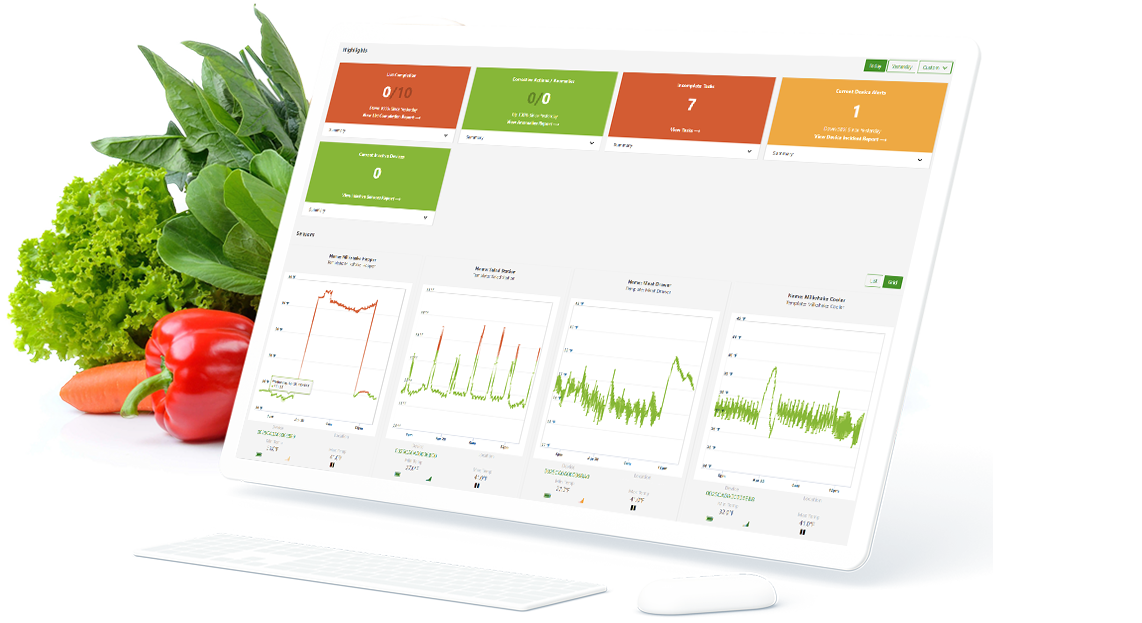
Foodborne illness leaves an estimated 48 million Americans sick and causes thousands of deaths every year, according to the CDC.
The most common culprits include Norovirus, Salmonella, E. coli, and others, but these pathogens are only part of the problem. The key to eliminating the effects of these critical potential problems is a well thought-out, implemented, and monitored food safety management system. Without this structure in place, it puts organizations and their guests at risk.
Here are the top risks facing restaurants and other foodservice operators:
Practicing poor personal hygiene
Risk: The most common cause of foodborne illness is spreading pathogens via touch. When foodservice workers do not maintain adequate personal hygiene and/or do not use appropriate protective equipment (or do not use it correctly), they can quickly contaminate clean foods. Some employees fail to wash their hands properly while on the job.
Solution: Correct hand-washing technique (at least 20 seconds) combined with correct use of protective gear like face masks and food-grade gloves are the best defenses against foodborne illness outbreaks.
Failing to cook food correctly
Risk: To kill pathogens and parasites, it’s imperative to cook foods to a sufficient temperature, especially when reheating already cooked foods. The minimum safe internal temperature varies according to the food being prepared but generally ranges between 145¡F and 165¡F, per the FDA.
Solution: Operators need a system that can reliably monitor temperatures, combined with procedures that ensure staff do so consistently. If possible, use a thermometer that captures the temperature electronically.
Holding food at incorrect temperatures
Risk: Once cooked, food must be held at safe temperatures. If food is allowed to sit until its internal temperature reaches the “danger zone” of 40¡F to 140¡F, then pathogens can begin to proliferate again. Food either needs to be stored at temperatures below 40¡F (refrigerated or frozen), or continuously heated to 140¡F or higher.
Solution: Make sure your food safety processes account for regular temperature checks; even better, you can automate the process with digital solutions that can generate automatic alerts whenever temperatures go out of spec.
Purchasing food from unsafe sources
Risk: Foodstuffs should be sourced from trusted and reliable vendors. Counterfeit foods—a growing problem that costs the industry as much as $15 billion annually, according to the FDA—can lead to safety issues. Food products purchased from unsafe sources increase the risk that the final product will be compromised as well.
Solution: Think of it as the “garbage in, garbage out” principle of foodservice. Use only credible, reputable vendors, and inspect packages before accepting delivery. Follow your franchisor’s recommendations if possible.
Using contaminated equipment

Risk: Although the use of contaminated equipment is less likely to cause foodborne illness than the risks named above, it nevertheless presents a risk. For example, one of the production machines at Blue Bell Creameries’ Broken Arrow facility became contaminated with listeria in 2015, which contributed to an outbreak that resulted in three deaths. Equipment-related risks can be quite subtle—for example, if an operation uses plastic cutting boards, the knife scoring can create divots that, though tiny to the human eye, are the perfect environment for microorganisms to breed.
Solution: Equipment normally has manufacturers’ guidelines on use and cleaning. Following these guidelines is critical to operating a safe foodservice establishment. Employees should also be aware of the dangers of washing meat in the sink.
Failing to adequately protect against COVID-19
Risk: While the COVID-19 pandemic is mostly in the past, it vividly underscored the importance of proper safety and sanitation in a restaurant setting, and variants of the virus still persist. There is ample evidence demonstrating a relationship between restaurant dining and community transmission of the infection.
Solution: Restaurants and similar facilities should remain diligent about practicing basic food safety and minimizing the risk of transmission, including implementing social distancing inside their stores and alternatively turning to delivery, takeout, drive-thru, and outdoor dining. These are sound practices in general to promote food safety.
Lack of visibility into the back of house
Risk: In many ways, the lack of visibility may be the most serious one facing foodservice operations today. How do you know if your brand, individual stores, or individual employees are engaging in the risky behaviors described above? Most don’t know, and without visibility into the actual behaviors every day, the biggest risk is assuming that everything is okay until a brand is blindsided by a food-related crisis it never knew had been brewing.
Solution: With enterprise visibility tools like those offered by ComplianceMate, it’s easy to see the proverbial dark corners of your restaurant. The system should ensure that operating procedures are completed on a timely basis, that aberrations are reported and controlled and that real time as well as periodic information is available to appropriate levels of management.
Missing “last mile” monitoring
Risk: “Last mile” is a term used in supply chain management that refers to the last steps a product takes to reach its final destination. Unfortunately, the last mile is often a weak point in safety monitoring. For example, as a food product is delivered and unloaded, it can often end up sitting for longer than expected without temperature monitoring. This concept applies more broadly though. Consider how COVID-19 has shifted focus onto delivery and takeout formats which can leave food sitting on a shelf waiting to be picked up, also without adequate monitoring.
Solution: Using automated sensors and tablet-based log sheets help add monitoring to the last mile. They can point out problems as they occur and also document compliance with organization procedures.
Making business trade-offs that sacrifice food safety in favor of other priorities
Risk: In an industry that was hit hard by the pandemic—there are an estimated 72,000 fewer restaurants now compared to 2019—many foodservice operations find themselves forced to make hard decisions that can have implications for food safety, choosing between efficiency, profitability, and safety. Ted Curry, Senior Transformation Consultant for Myrtle Consulting Group, told Food Industry Executive that “the trade-off between food safety and production uptime is a false choice.”
Solution: As stated by Curry, reducing waste and becoming more efficient can happen naturally if operations prioritize doing things “the right way” from the start.
Untrained employees

Risk: Untrained employees pose a hazard as they may lack the knowledge of safe food handling practices. Inadequate training can result in improper cooking, cleaning, and storage techniques. This can lead to serious food safety violations.
Solution: Invest in comprehensive food safety training programs for all staff members. Regularly update training to include the latest food hygiene practices and compliance requirements.
Unsafe ingredient storage
Risk: Improper storage of ingredients can lead to spoilage and contamination. Inadequate temperature control and poor storage practices can result in the growth of harmful bacteria that compromise food safety.
Solution: Store ingredients at appropriate temperatures and conditions. Label and date all stored items to ensure proper rotation. As always, ComplianceMate’s temperature monitoring systems can help maintain safe storage environments.
Improper handling of ready-to-eat food
Risk: Mishandling ready-to-eat foods can result in cross-contamination and foodborne illnesses.
Solution: Train staff to handle ready-to-eat foods with care, using separate utensils and equipment. Implement strict hygiene practices, such as wearing gloves and sanitizing surfaces. ComplianceMate’s digital checklists can help ensure adherence to safe food handling protocols.
Incorrect reheating of food
Risk: Reheating foods incorrectly can leave harmful bacteria alive and lead to potential foodborne illnesses. Contact with contaminated surfaces, utensils, or hands can transfer pathogens to food that will not be cooked before consumption
Solution: Use food thermometers to ensure that reheated foods reach safe temperatures. Train staff on proper reheating techniques to avoid food safety issues. ComplianceMate’s temperature logging solutions can help verify that reheating processes meet safety standards.
Pest infestations
Risk: Pest infestations can contaminate food as well as food-preparation surfaces. Pests such as termites and cockroaches can introduce pathogens and allergens, leading to contamination and potentially severe foodborne illnesses, as well as reputational damage to the business.
Solution: Implement a comprehensive pest control program, including regular inspections and sanitation measures. Train staff to recognize signs of infestations and respond promptly.
How can these risks be mitigated?

To develop a risk management and mitigation plan, operators must first recognize and understand the risks they face and often inadvertently create. That’s easier said than done. Beyond the usual suspects—like storing and preparing foods at inappropriate temperatures—many safety risks are easy to miss.
An IoT System Reduces Risk
Foodservice organizations need a risk management strategy that includes a reliable enterprise-wide system to capture and communicate real-time information. Without it, most brands are exposing themselves and their guests to unacceptable threats. In fact, the best means of eliminating these kinds of food safety concerns is having access to proactive data monitoring and alerting of potential threats the business faces on a daily basis.
Automated and real-time visibility to these risk factors is necessary to prevent food safety hazards. A system that leverages Internet of Things (IoT) sensors supports this objective.
ComplianceMate uses the power of IoT technology to ensure proper food safety in a wide range of environments. Whether you’re involved in the foodservice, restaurant, retail, healthcare, hospitality, travel or educational sector, ComplianceMate can be an invaluable aid in promoting food hygiene.
LEARN MORE: IoT technology can be easily utilized to reduce your foodservice risks. Request a no-obligation demo today.



